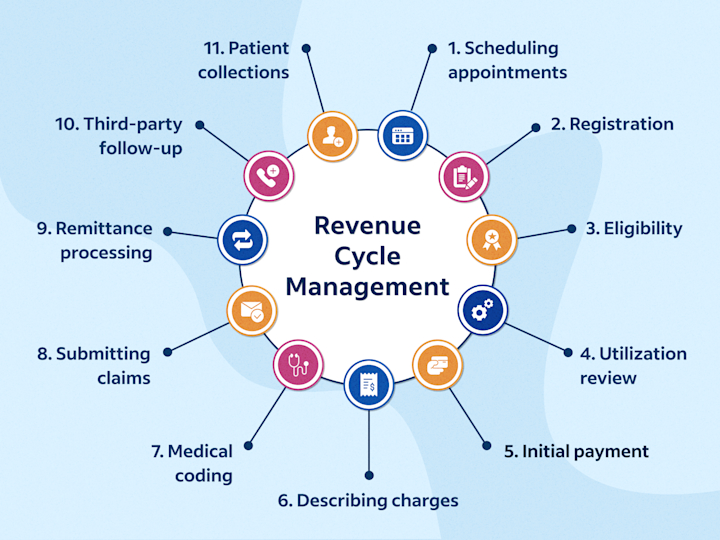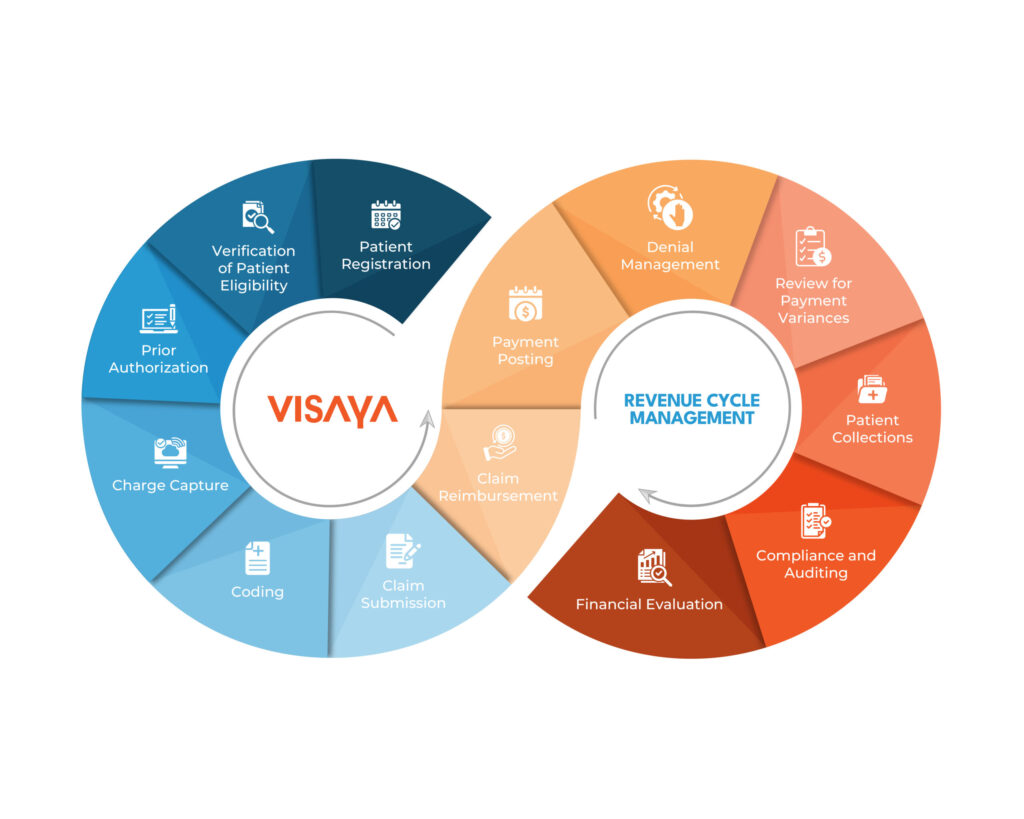Introduction: The Growing Importance of Revenue Cycle Management Solutions Healthcare
In today’s complex healthcare environment, workflow efficiency and financial sustainability hinge on streamlined medical billing processes. Revenue Cycle Management Solutions Healthcare play a vital role in transforming chaotic billing systems into robust, accurate revenue engines. These solutions combine technology, automation, and expert oversight to reduce errors, denials, and delays ensuring healthcare providers get paid promptly and fully.
1. Understanding Medical Billing Challenges
Medical billing involves intricate steps—from accurate coding and claim submission to denial handling and payment posting. Missteps at any point can lead to claim denials, compliance issues, and cash flow disruption. Providers face challenges such as evolving payer rules, manual data entry errors, and high administrative overhead. Integrating Revenue Management Solutions Healthcare helps mitigate these issues by ensuring more reliable and compliant billing workflows.
2. Core Features of Effective Revenue Management Solutions Healthcare
Effective systems include several key capabilities:
- Automated Claim Submission: Automatically validates and submits claims to payers, reducing human error.
- Denial Management: Flags and resolves denied claims through root-cause analysis and resubmission workflows.
- Analytics & Reporting: Offers dashboards and KPIs to monitor claim status, A/R aging, and denial trends.
- Interoperability: Seamlessly integrates with EHR/EMR systems, insurers, and financial platforms for smooth data exchange.
For example, Conifer Health’s solutions often in the realm of Revenue Management Solutions Healthcare include front-end (patient access), mid-cycle (clinical revenue integrity), and back-end (A/R management) tools to optimize workflow and accelerate payments Conifer Health Solutions.
3. How Automation Drives Billing Efficiency
Automation is at the heart of modern revenue management. Tools like Waystar’s cloud-based platform use AI to automate tedious tasks, reduce errors, and accelerate financial outcomes. Their Altitude AI™ platform has shown benefits such as a 50% reduction in patient A/R days and increased automation of back-office tasks Waystar.
Similarly, Omega Healthcare uses AI-driven document processing to automate billing tasks like insurance claim processing and data extraction. This AI integration has cut documentation time by 40%, saved 15,000 employee hours per month, and delivered a 30% ROI for clients Business Insider.

4. Outsourcing Versus In-House Billing Solutions
Healthcare organizations often choose between handling billing internally or outsourcing to providers of Revenue Management Solutions Healthcare. Outsourced services, such as Pinnacle’s RCM offerings, bring experienced teams, efficient workflows, and compliance expertise to the table. Pinnacle supports billing, denial management, analytics, and advisory all while allowing healthcare staff to focus on patient care Pinnacle Healthcare Consulting.
Such solutions deliver operational improvements like reduced billing costs, increased collection rates, and reliable cash flow.
5. Leveraging Data for Smarter Billing
Data is powerful. Revenue management solutions with analytics and predictive tools enable:
- Root-Cause Analysis of denials to prevent recurring errors.
- Real-Time Performance Monitoring for billing teams.
- Predictive Modeling to prioritize high-value claims and appeals.
Some AI systems can even anticipate payer behavior and denial patterns, enabling proactive adjustments in billing strategy and empowering teams to capture more revenue through predictive denial prevention.
Looking to improve your practice’s billing efficiency? Understanding key billing principles
6. Strategic Implementation: Best Practices
To adopt Revenue Management Solutions Healthcare effectively:
- Map Existing Workflows: Identify bottlenecks in claim submission, denial handling, and payments.
- Set Measurable KPIs: Track metrics like clean claim rate, denial rate, days in A/R.
- Pilot Test Components: Introduce modules (e.g., denial management) before scaling across the organization.
- Ensure Ongoing Training: Keep staff updated on payer rules, coding changes, and software features.
- Use Dedicated Support: Choose vendors offering reporting, analytics, and consultative services.
This structured approach ensures smoother transitions and maximizes return on investment.
7. Future of Revenue Management in Healthcare
The future will be shaped by AI, predictive analytics, and deeper connectivity:
- AI will drive intelligent claim routing and denial prevention.
- Predictive systems will forecast cash flow and billing trends.
- Cloud platforms will offer scalable, secure revenue workflows integrated directly with clinical systems and payer networks.
Providers adopting Revenue Management Solutions Healthcare today are better positioned for long-term financial stability and administrative resilience.
Summary Table of Key Elements
| Focus Area | Key Benefit |
|---|---|
| Claim Automation | Faster submissions |
| Denial Resolution | Reduced revenue loss |
| Analytics | Enhanced financial insight |
| Interoperability | Seamless system integration |
| Outsourcing Expertise | Operational efficiency |
| AI & Predictive Tools | Proactive revenue optimization |
Revenue Cycle Management Solutions Benefits
These solutions improve cash flow, reduce claim denials, and enhance compliance with payer requirements. They also provide better financial visibility through advanced analytics and reporting tools.
Accurate and Clear Documentation
Accurate documentation ensures that all medical services are coded and billed correctly. Clear records also protect providers during audits and support proper reimbursement.
Avoid Common Billing Errors
Billing errors can lead to delayed or denied claims, directly impacting revenue. Revenue management tools help identify and prevent mistakes before submission.
Submit Clean Claims
Clean claims are error-free and ready for payer processing on the first submission. This speeds up payments and minimizes the need for resubmission.
Verify Insurance Coverage and Analyze Reports
Verifying insurance coverage before service reduces the risk of claim denials. Analyzing reports provides insights into revenue trends, payer behavior, and operational efficiency.
Why Revenue Management Is Critical for Healthcare Providers
Optimizing Medical Billing with Revenue Management Solutions Healthcare
Efficient revenue management ensures a steady cash flow, which is essential for sustaining operations and patient care quality. Without it, providers face delayed payments and financial strain.
Key Components of a Healthcare Revenue Management System
Core components include patient access management, charge capture, coding, claim submission, payment posting, and denial management. Together, they form a complete framework for managing revenue efficiently.
Front-End Processes: Setting the Stage for Accurate Billing
Front-end processes include patient registration, insurance verification, and pre-authorization. These steps ensure accurate data entry and reduce claim errors downstream.
Back-End Processes: Ensuring Timely Payments and Collections
Back-end processes involve posting payments, managing accounts receivable, and following up on unpaid claims. Strong back-end management keeps cash flow consistent and predictable.

Technology’s Role in Modern Healthcare Revenue Management
Modern technology like AI and automation reduces manual errors, accelerates claim processing, and improves reporting accuracy. Cloud-based platforms also allow for secure, real-time data sharing.
Common Challenges in Healthcare Revenue Management
Frequent coding updates, payer policy changes, and staff shortages can hinder efficiency. High denial rates and slow reimbursements remain persistent challenges for many providers.
Best Practices for Optimizing Revenue Cycle Performance
Best practices include regular staff training, proactive denial management, and leveraging analytics to monitor KPIs. Continuous process improvement ensures maximum revenue capture and compliance.
Conclusion
In summary, Revenue Management Solutions Healthcare serve as a cornerstone in modern medical billing. By combining automation, analytics, outsourcing options, and strategic implementation, healthcare organizations can vastly improve billing accuracy, accelerate revenue, and reduce administrative burdens—without resorting to case studies. The future holds even more promise, with AI and predictive tools enabling smarter, faster, and more reliable billing operations.
FAQs
Can these solutions reduce claim denials?
Yes, denial management features identify common reasons for rejections and fix them before resubmitting. Over time, this proactive approach reduces overall denial rates.
Are Revenue Management Solutions Healthcare suitable for small practices?
Absolutely. Many vendors offer scalable systems tailored to the needs of small and medium-sized healthcare providers, ensuring affordability and ease of use.
What role does automation play in revenue cycle management?
Automation speeds up claim submission, payment posting, and reporting while minimizing manual errors. This allows staff to focus more on patient care and less on administrative work.
How can providers choose the right revenue management solution?
They should consider factors like integration with existing systems, scalability, cost, compliance features, and vendor support. A pilot program can help test functionality before full adoption.

